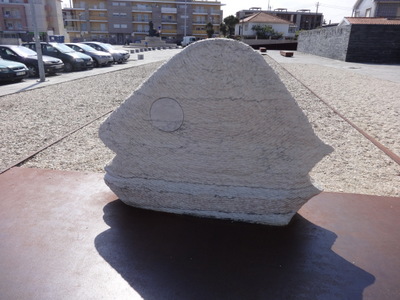
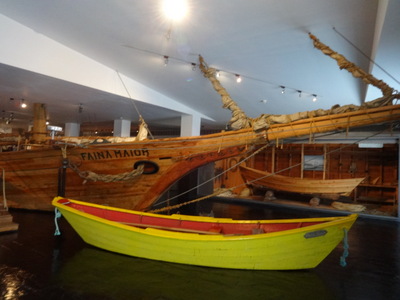 Slept in after the late night in Porto. I met Kathy, Jeannie, and Sue Weiler about 10 a.m., and we took a cab to the maritime museum in Ilhavo, about 5 km away, beyond the university campus.
Slept in after the late night in Porto. I met Kathy, Jeannie, and Sue Weiler about 10 a.m., and we took a cab to the maritime museum in Ilhavo, about 5 km away, beyond the university campus. Thursday, 3 September 2015: The Maritime Museum
Written 15 June 2016

 Slept in after the late night in Porto. I met Kathy, Jeannie, and Sue Weiler about 10 a.m., and we took a cab to the maritime museum in Ilhavo, about 5 km away, beyond the university campus.
Slept in after the late night in Porto. I met Kathy, Jeannie, and Sue Weiler about 10 a.m., and we took a cab to the maritime museum in Ilhavo, about 5 km away, beyond the university campus.
The museum tries to cover all things maritime in Portugal but emphasizes the historic rather than modern-day fishing fishing practices. A central exhibit is the Faina Maior, a full-size replica of a cod-fishing schooner from the first quarter of the 20th century. It was patterned after the Hortense, which was built in the last quarter of the 19th century and was actively used until about 1905. The replica is about 30 m long, 6.1 m wide, and 2.3 m deep.
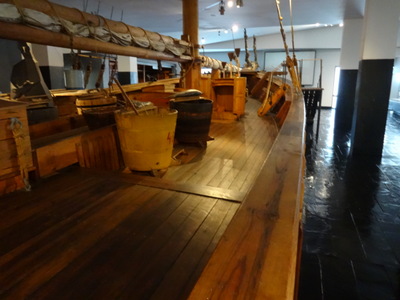
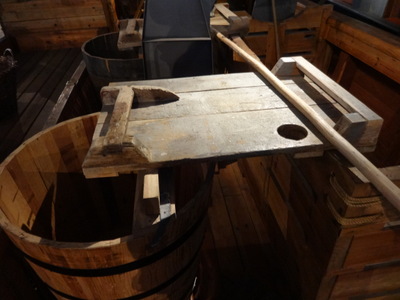
Such a schooner would carry stacks ("nests") of dories, like the bright yellow one here. On the fishing grounds, individual fishermen would take the dories out and fish for cod with hook and line, piling as many into their boats as would fit before rowing back to the schooner. In those days, adult cod were about a meter long.
At shipside, the fisherman would be handed a pitchfork which which to heave his fish aboard. Once they were all back, the fish all transferred to schooner, and the dories restacked on deck, the fishermen would pause for a hot meal, then start dressing the fish. Groups of three would work together, at cutting boards like the one in the right-hand photo.
One man would would cut the head partly off and slit the belly, the next would gut the fish and remove the head, and the third would split the cod lengthwise so that it could be laid flat for salting in the hold. The faces, tongues, and air bladders were also salted, and the livers set aside for cod liver oil.
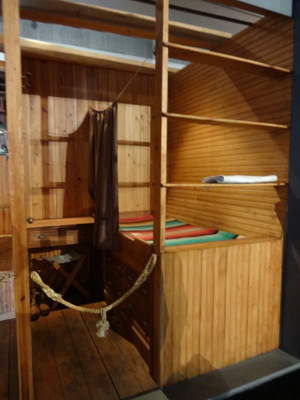
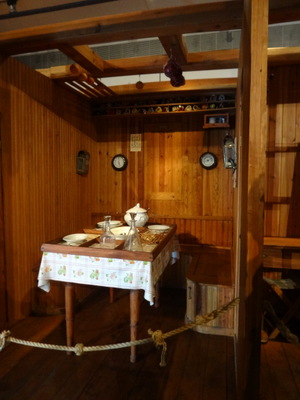 Here are a replica berth and mess table, clearly from a larger vessel than the Faina Maior and probably for relatively high-ranking officers. Ordinarily crew members probably slept in hammocks and didn't have book shelves.
Here are a replica berth and mess table, clearly from a larger vessel than the Faina Maior and probably for relatively high-ranking officers. Ordinarily crew members probably slept in hammocks and didn't have book shelves.
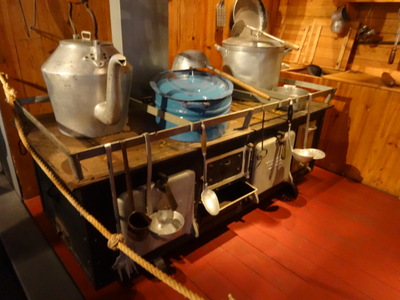
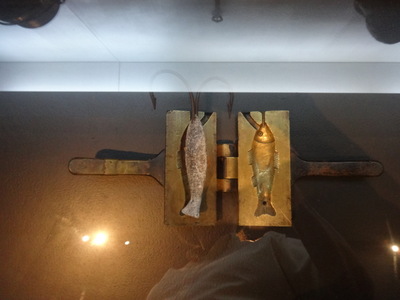 The cook who used this galley must have cooked for a fair-sized crew, judging from the sizes of the pots, which seem almost too big for the stove.
The cook who used this galley must have cooked for a fair-sized crew, judging from the sizes of the pots, which seem almost too big for the stove.
The exhibits also covered many of the crafts ancillary to boatbuilding and fishing. The photo at the right shows a mold used to make lead fishing weights. This one produces weights shaped like little fish, but others were more utilitarian, simply producing elongated teardrops or cylinders.
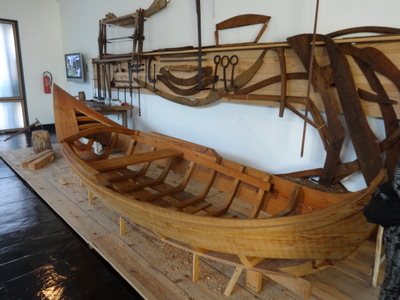
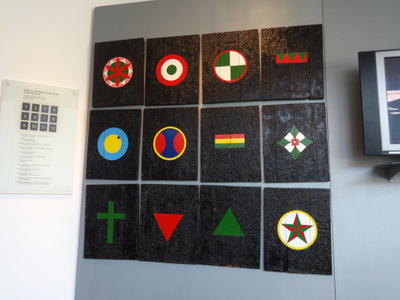 Here is a replica of a boat-builder's shop, with a half-finished boat on the rack and all the wood-shaping tools hung around it on the walls.
Here is a replica of a boat-builder's shop, with a half-finished boat on the rack and all the wood-shaping tools hung around it on the walls.
The photo at the right shows the symbols used by the boat-builders of Aveiro to mark vessels they had constructed. The key to the left of the brightly painted symbols tells which boat-builder each belonged to. We had noticed these markings on the salt gondolas giving tours on the canals and wondered whether they were simply decorative.
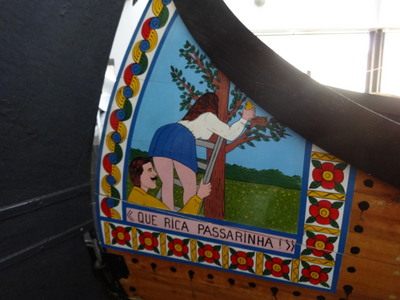
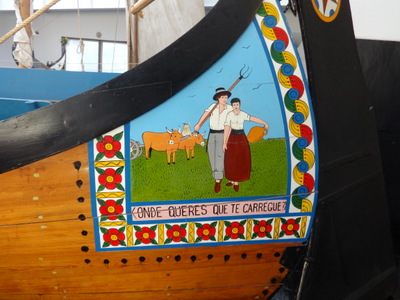 Here are images of the scenes painted on the sterns of a couple salt gondolas. The one at the left is pretty clearly suggestive, but I'm not sure about the one on the right.
Here are images of the scenes painted on the sterns of a couple salt gondolas. The one at the left is pretty clearly suggestive, but I'm not sure about the one on the right.
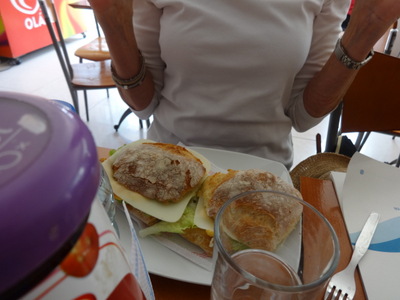
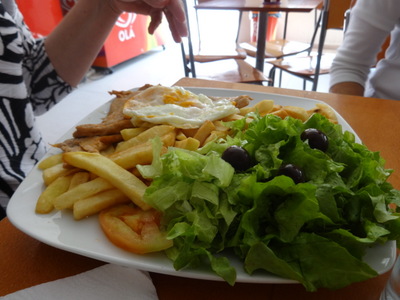 Our tickets were good all day, so noontime we consulted the museum staff about where to look for lunch and set off down the street in a promising direction.
Our tickets were good all day, so noontime we consulted the museum staff about where to look for lunch and set off down the street in a promising direction.
We settled at a local bakery that also made hot sandwiches. I think sandwiches at the left are omelet, cheese, lettuce, and tomato, and the dish at the right was described on the menu as "meat with an egg on top."
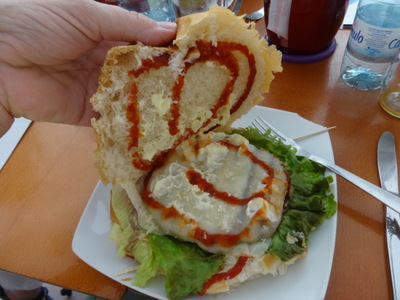
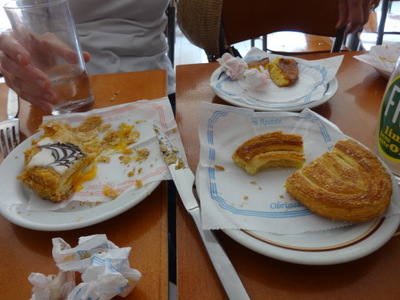 I ordered a cheeseburger (show here at the left, striped with ketchup), which I'm pretty sure was made of pork.
I ordered a cheeseburger (show here at the left, striped with ketchup), which I'm pretty sure was made of pork.
At the right are our desserts: pastel de nata, napolean, and elephant ear.
Not a bad lunch, at a very friendly and welcoming establishment.
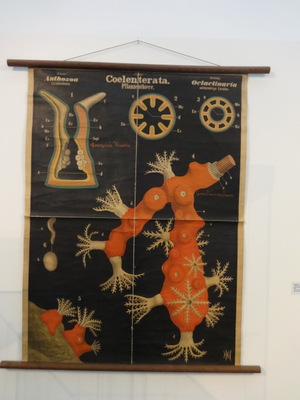
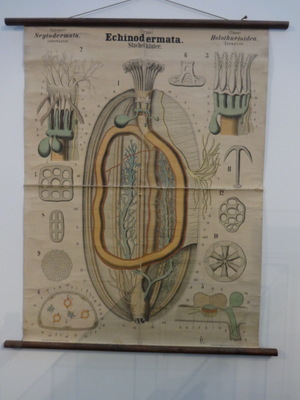 Then it was back to the museum for the natural history section. I liked these antique anatomical charts, made for invertebrate zoology courses and labeled in German.
Then it was back to the museum for the natural history section. I liked these antique anatomical charts, made for invertebrate zoology courses and labeled in German.
A number of cases held the usual stuffed marine birds and animals, mostly those of Portugal.
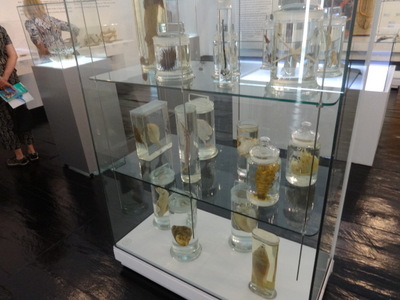
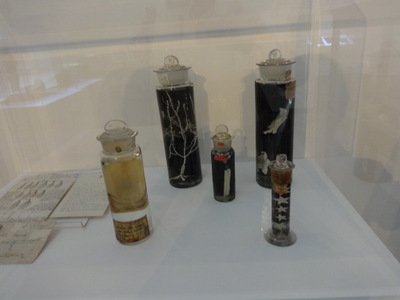 Even more cases were devoted to jars of preserved sea creatures.
Even more cases were devoted to jars of preserved sea creatures.
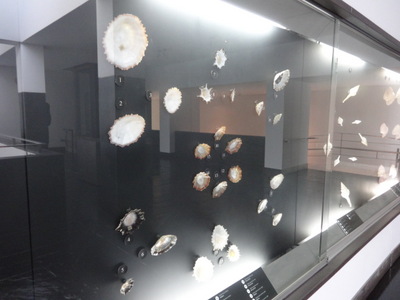
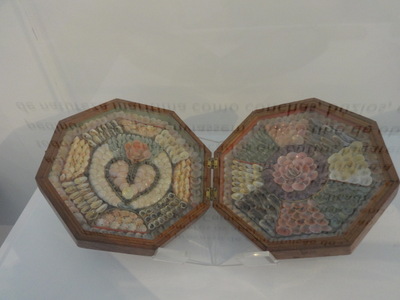 Several walls were covered with displays of mollusc shells. Most were correctly labeled and arranged according to systematic groups, but a few pieces of "shell art" were also included, like the hinged box shown in the right-hand photo, which contained shells arranged in purely aesthetic patterns.
Several walls were covered with displays of mollusc shells. Most were correctly labeled and arranged according to systematic groups, but a few pieces of "shell art" were also included, like the hinged box shown in the right-hand photo, which contained shells arranged in purely aesthetic patterns.
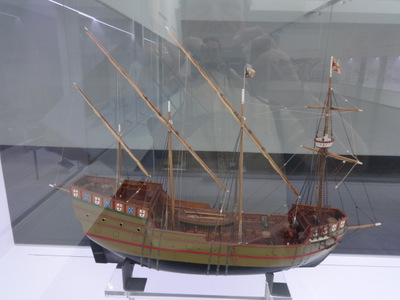
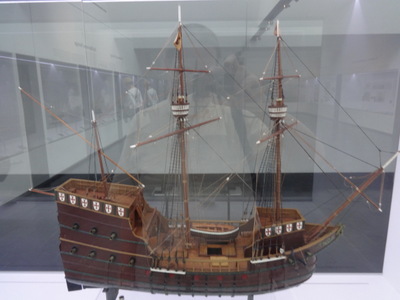 A whole room was devoted to model ships illustrating the various styles made and used in Portugal. The one in the photo at the left is a caravel, the design made famous in the Portuguese age of exploration.
A whole room was devoted to model ships illustrating the various styles made and used in Portugal. The one in the photo at the left is a caravel, the design made famous in the Portuguese age of exploration.
The photo at the right shows a "nau," with a taller structure at the stern.
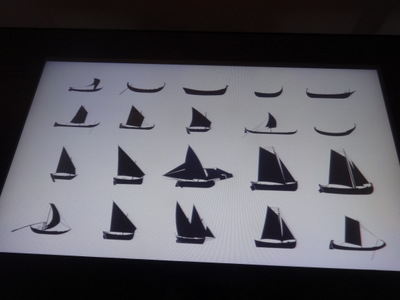
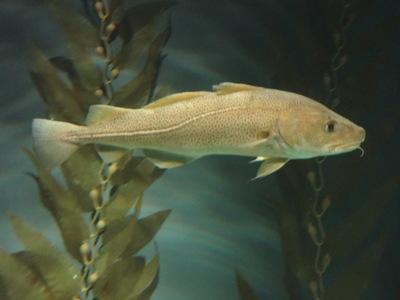 This helpful poster summarized the lines, silhouettes, and riggng of all the small craft of the area.
This helpful poster summarized the lines, silhouettes, and riggng of all the small craft of the area.
Finally, we came to the last section of the museum, the aquarium. Outside its entrance, a huge chart on the wall summarized the cod and all its near relatives. A painting of each species was labeled with its Latin and and Portuguese common names, favored habitat, feeding habits, size, climate zone, and longevity. A smaller mural illustrated the gadid life cycle. I won't insist on showing you all of it (I had to take six photos to cover all of it), but I'll certainly be studying it and taking notes myself!)
The photo at the right here shows an actual cod (good old Gadus morhua), one of many of various sizes swimming placidly around in the acquarium's biggest tank.
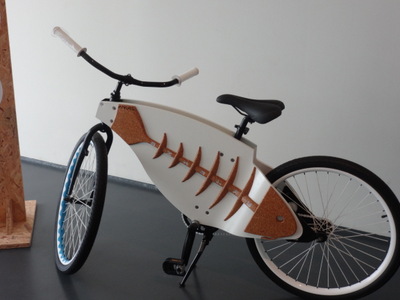
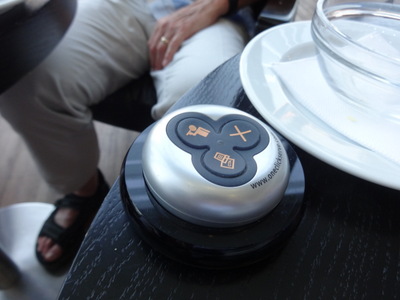 The Portuguese word for dried salt cod (and they don't really eat any other kind) is "bacalão," and the museum's gift shop displayed this "bikelão." I'm not sure whether or not it was for sale.
The Portuguese word for dried salt cod (and they don't really eat any other kind) is "bacalão," and the museum's gift shop displayed this "bikelão." I'm not sure whether or not it was for sale.
About 4 p.m., we got a cab back to the hotel to await the return of the male contingent from the meetings. In the hotel's bar, each table was equipped with the handy device shown at the right, on which one button called for a waiter, another asked for the bill, and I think the third just called for another round.
After spending some time looking at the symposium's poster session, we trooped out once again in search of dinner. I didn't even take note of where we ended up, but I did take photos of the food.
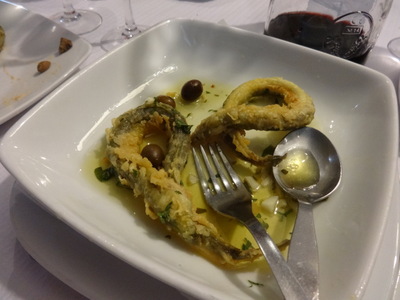
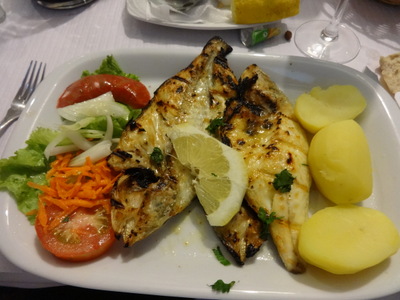 Eels, of course. These are bent around into teardrop shapes for frying and serving. I notice, in the course of the week, that the eels got larger and the bones less edible. The first ones I had were entirely edible. In the second or third batch, the larges two or three vertebrae were too hard to chew. By the end of the week, the whole vertebral column was too hard (though it remained very easy to strip the meat off it with fingers or a fork). I don't know whether the eels being caught really aged that fast, ossifying as the week progressed, or whether they are sold in size classes and I just coincidentally encountered them in size order. Delicious in any size class.
Eels, of course. These are bent around into teardrop shapes for frying and serving. I notice, in the course of the week, that the eels got larger and the bones less edible. The first ones I had were entirely edible. In the second or third batch, the larges two or three vertebrae were too hard to chew. By the end of the week, the whole vertebral column was too hard (though it remained very easy to strip the meat off it with fingers or a fork). I don't know whether the eels being caught really aged that fast, ossifying as the week progressed, or whether they are sold in size classes and I just coincidentally encountered them in size order. Delicious in any size class.
At the right is another grilled robalo, alas not the equal of the wonderful specimen at the fish market's restaurant.
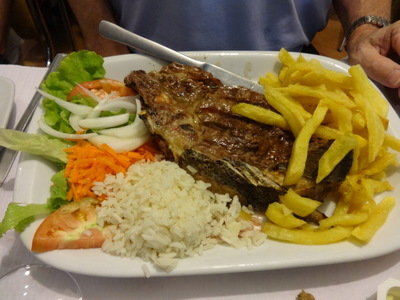
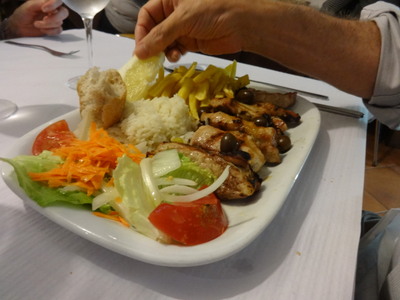 At the left here is what looks like a steak of some sort.
At the left here is what looks like a steak of some sort.
At the right, I have no idea. Chicken wings? Ribs? Because they came with a lemon wedge, they might well have been slices of grilled fish.
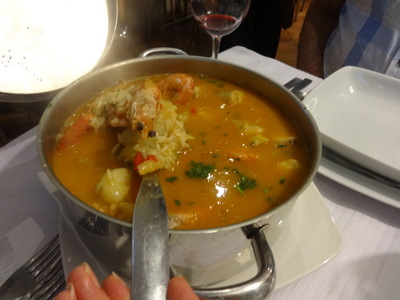
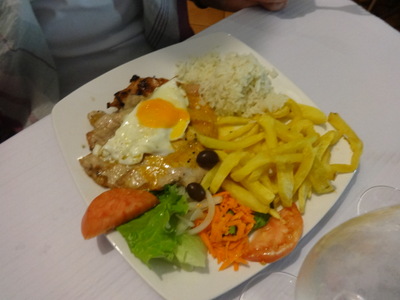 At the left here is probably "seafood with rice," a common item on menus but one I never tried. Other things came "with rice" as well.
At the left here is probably "seafood with rice," a common item on menus but one I never tried. Other things came "with rice" as well.
Finally, at the left right, another cutlet of something with an egg on top.